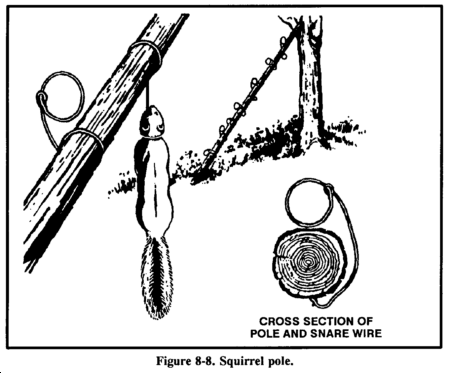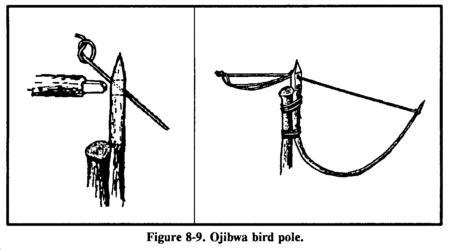Squirrel Pole
A squirrel pole is a long pole placed against a tree in an area showing a lot
of squirrel activity (Figure 8-8). Place several wire nooses
along the top and sides of the pole so that a squirrel trying to go up or down the pole
will have to pass through one or more of them. Position the nooses
(5 to 6 centimeters in diameter) about 2.5 centimeters off the pole. Place the top and
bottom wire nooses 45 centimeters from the top and bottom of the pole to prevent
the squirrel from getting its feet on a solid surface. If this happens, the squirrel will chew
through the wire. Squirrels are naturally curious. After an initial period of caution, they
will try to go up or down the pole and will get caught in a noose. The
struggling animal will soon fall from the pole and strangle. Other squirrels
will soon follow and, in this way, you can catch several squirrels. You can
emplace multiple poles to increase the catch.

Ojibwa Bird Pole
An Ojibwa bird pole is a snare used by native Americans for centuries
(Figure 8-9). To be effective, place it in a relatively open
area away from tall trees. For best results, pick a spot near feeding areas, dusting
areas, or watering holes. Cut a pole 1.8 to 2.1 meters long and trim away all limbs
and foliage. Do not use resinous wood such as pine. Sharpen the upper end to a
point, then drill a small diameter hole 5 to 7.5 centimeters down from the top.
Cut a small stick 10 to 15 centimeters long and shape one end so that it will
almost fit into the hole. This is the perch. Plant the long pole in the ground
with the pointed end up. Tie a small weight, about equal to the weight of the
targeted species, to a length of cordage. Pass the free end of the cordage
through the hole, and tie a slip noose that covers the perch. Tie a single
overhand knot in the cordage and place the perch against the hole. Allow the
cordage to slip through the hole until the overhand knot rests against the pole
and the top of the perch. The tension of the overhand knot against the pole and
perch will hold the perch in position. Spread the noose over the perch, ensuring
it covers the perch and drapes over on both sides. Most birds prefer to rest on
something above ground and will land on the perch. As soon as the bird lands,
the perch will fall, releasing the over-hand knot and allowing the weight to
drop. The noose will tighten around the bird's feet, capturing it. If the weight
is too heavy, it will cut the bird's feet off, allowing it to escape.

Noosing Wand
A noose stick or "noosing wand" is useful for capturing roosting birds or
small mammals (Figure 8-10). It requires a patient operator.
This wand is more a weapon than a trap. It consists of a pole (as long as you can
effectively handle) with a slip noose of wire or stiff cordage at the small end. To catch
an animal, you slip the noose over the neck of a roosting bird and pull it tight. You can
also place it over a den hole and hide in a nearby blind. When the animal emerges from the
den, you jerk the pole to tighten the noose and thus capture the animal. Carry a
stout club to kill the prey.

| Updated:
12 January 2008 |
|
Born on 28 October 1999 |



